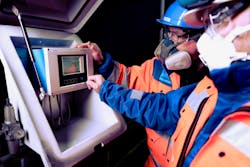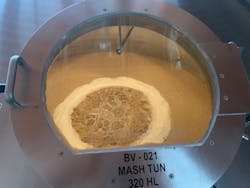How Process Sensors Provide More Intelligence
Process sensor technology—the mainstay instrumentation that monitors temperature, pressure and flow levels—has remained fairly steady over the years against a backdrop of accelerating digital transformation in the automation and controls space. Yet advances in signal processing and communications, coupled with more pervasive on-board intelligence, is opening up new roles for process sensors as use cases for proactive maintenance and inventory monitoring gain traction.
Traditionally, rotating equipment like motors or pumps have not been serviced proactively. Instead they were more commonly attended to when equipment failed or when a preset schedule prescribed their maintenance. This dynamic is changing as manufacturers expand the role of process sensors not just for control applications, but also for condition monitoring.
“A lot of things people did on field rounds with their eyes or ears is now done by monitoring equipment,” says Achal Nath, senior director, product manager for Honeywell’s Process Measurement and Control (PMC) business. “With the Industrial Internet of Things (IIoT), there’s now sensing available to see if equipment is degrading and needs maintenance.”
Advances made to process sensors as part of expanded capabilities for IIoT applications has resulted in process sensors no longer focusing on a single measurement like temperature or flow. Now they offer multi-sensing capabilities and an ability to store more data. Access to additional process information and sensor health data elevates their utility and gives plant builders and engineers more opportunity to streamline processes, gain efficiencies and reduce costs. “The more information they receive, the better,” adds Thomas Chirdo, product marketing manager for liquid analysis at Endress+Hauser.
Following are three examples of how manufacturers are pushing process sensors to the next level.
Brewing up continuous measurement
Temperature, density and concentration are the essential measurement ingredients that can alter the flavor of beer.
To get real-time visibility into each step in its process and combine key measurements on a single sensor platform, craft brewer New Belgium Brewing exchanged a mag flow meter tasked with measuring volumetric flow for a Coriolis meter that monitors flow along with density. The recipe served up a true measurement for mass while concocting a continuous process that turns out a tastier brew.
Emerson’s H300 Micro Motion Coriolis sensor, buttressed by the Rosemount X-Well technology, are the staple technologies behind New Belgium Brewing’s continuous measurement. Gilliland said the brewery always wanted to do more with its sensor platform, and when Emerson proposed a partnership around the Micro Motion Coriolis and Rosemount X-Well technologies, it was an opportunity too tempting to pass up. “We knew we could learn more about our processes if we had a continuous measurement piece,” he says.
The Rosemount X-Well system polishes up already accurate measurements from the Coriolis sensor. “It adds a level of precision especially in an environment that has changing temperatures and processes,” says Bobby Seal, test engineer at Emerson.
Taking advantage of the Coriolis meter’s multi-sensing capabilities and leveraging the data collected to learn more about production processes for continuous optimization is a lesson Gilliland and Seal hope others can learn from. “What you do with the data is huge,” says Seal. “We have customers that are presented with a Corolis sensor and only use it as a flow switch when you can do so much more.”
For its part, the brewery plans to leverage the data for a Six Sigma black belt project to gain more efficiency from its equipment in the next stage of its journey, Gilliland says.
While myriad brewery applications call for simple density measurements, Gilliland says this process was unique in that the density measurement had impact on so much else. That’s why the choice of the Corolis/X-Well technologies for multi-sensing and continuous measurement was key. “The density changes during this process have a big effect on how much extract we’re getting out, so this was a unique marriage of need and capabilities,” he explains. “Continuous monitoring gives us the smarts to see the sum total of how one change impacts density right away. It’s in a perfect place to play with our process.”
Remote monitoring
When you operate a plant that pumps out a broad range of custom-formulated coatings and paints, tank inventory monitoring capabilities are crucial for knowing how much of any one chemical is on-hand.
A.P. Nonweiler Company had a reliable monitoring system in place to keep tabs on inventory levels in its 24 chemical storage tanks—Siemens Sitrans LR250 local-level transmitters outfitted on individual tanks which communicate to a Honeywell data recorder via a local Ethernet network. This system, however, still required the plant manager to physically make the rounds to check tank fill levels on a daily basis. Specifically, the tank-level measurements, crucial for maintaining the right levels of inventory for efficient production, had to be read directly from the recorder or operations PC with no option for remote access.
The decision to use these Siemens technologies boiled down to wanting the benefits of remote monitoring capabilities without having to do a major reconfiguration or incur any kind of capital expense that would have to be signed off at higher levels of management, according to Jack Roushey, manager of product marketing for Siemens U.S. “They weighed going to a full programmable logic control (PLC) set up, but that would have required a major hardware investment as well as a redo of their entire process,” Roushey explains. “This takes the available output, sends it up to the cloud and into the app where the information can be manipulated any way they want without impacting how they produce their product.”
The new set up gives the plant team real-time access to all product data from the tanks, enabling them to monitor status and receive alarm notifications regardless of where they are located. The IoT monitoring solution has helped A.P. Nonweiler improve operational efficiency, reduce unplanned production downtime, and meet or beat its delivery deadlines. The plan is to expand use of the app and harness the tank-level data for better insights and decision making.
In the near term, the ability to have ready access to critical tank-level metrics without having to be on-site is more than enough to justify the project, according to Doug De Witt, plant manager for A.P. Nonweiller. “I was able to go on vacation with the peace of mind that came from knowing my chemical tank storage levels in the plant at all times,” he says.
Digital sensor platform aids in mine safety
When your business is a gold mine that relies on a critical separation process using cyanide, keeping track of accurate pH levels is crucial, especially for avoiding safety hazards. The Agnico Eagle gold mine in Kittilä, Finland, needed consistent accuracy with its legacy pH sensor instrumentation. Plus, the required calibration and maintenance of the mine’s equipment routinely consumed too much time and plant resources.
After a year-long field trial in search of a pH sensor replacement platform, the Agnico Eagle gold mine chose on the Memosens and Liquiline liquid analysis digital transmitter and sensor combination from Endress+Hauser. The mine’s selection process was governed by a set of requirements, including the desire to reduce maintenance processes and chemical costs, increase safety and ensure reliable and accurate measurements in extreme physical conditions. Those drivers signaled it was time to make the leap to a digital process sensor platform after Endress+Hauser was able to demonstrate the benefits of its platform.
“Because there is no physical connection to transfer power and data between the probe and transmitter, they don’t have to worry about things specific to an analog sensors, like water intrusion, corrosion or inaccurate readings because a cable has shifted,” Chirdo says.
Calibration of instruments is the basis for reliable and accurate pH measurements, and there too, Memosens and Liquiline have an edge. The Memobase Plus calibration diagnostics and lab measurement software connects a Memosens sensor and computer via a USB port, eliminating the need to perform operations under difficult conditions in the field and reducing the time spent on maintenance and calibration from 2,200 labor hours annually to only 240. The more accurate pH measurements also helped to reduce the amount of chemicals used in the process, which cut costs while improving occupational safety. “With Memosens, there is no need to stay in the field for the pH electrode calibration—this is a huge improvement for safety,” says Reijo Mammioja, senior instrumentation engineer at Agnico Eagle Mine.
Read more about the Agnico Eagle gold mine case study from Endress+Hauser.
About the Author
Beth Stackpole, contributing writer
Contributing Editor, Automation World

Leaders relevant to this article:



